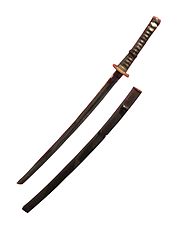The authentic Japanese sword is made from a specialized Japanese steel called "Tamahagane"[4] which consist of combinations of hard, high carbon steel and tough, low carbon steel[5]. There are advantages and setbacks to both types of steel. Having a lot of carbon within the steel allows the blade to hold a sharp edge but can be too brittle and may break in combat. Having a small amount of carbon will allow the steel to be more malleable, making it able to absorb impacts without breaking but becoming blunt in the process. The makers of a katana would use the best attributes of both kinds of steel by placing the high carbon steel in the front of the blade for a sharp edge while placing the low carbon steel in the back where it can absorb most of the impact.
The katana gets its gentle curve from quenching during forging, as it is straight prior to quenching. A process of differential tempering causes martensite to form predominantly in the edge of the blade rather than the back; as the spine has lower retained lattice strain, it cools and contracts, and the blade takes on a gently curved shape.[6]
A coating of clay mixed with ashes and a small portion of rust is applied to every surface but the edge of the blade during hardening. This provides heat insulation so that only the blade's edge will be hardened with quenching. This process also creates the distinct swerving line down the center of the blade called the hamon which can only be seen after it is polished, a katana forger's signature.
The hardening of steel involves altering the molecular structure of that material through quenching it from a heat above 800 °C (1,472 °F) (bright red glow), ideally no higher than yellow hot. If cooled slowly, the material will break back down into iron and carbon and the molecular structure will return to its previous state. However, if cooled quickly, the steel's molecular structure is permanently altered. The reason for the formation of the curve in a properly hardened Japanese blade is that iron carbide, formed during heating and retained through quenching, has a lesser density than its root materials have separately.
After the blade is forged it is then sent to be polished. The polishing takes between one and three weeks. The polisher uses finer and finer grains of polishing stones until the blade is like glass. This makes the blade extremely sharp and reduces drag making it easier to cut with. The blade curvature also adds to the cutting power. A katana must folded over a 1000 times before it is for complete.




0 comments:
Post a Comment